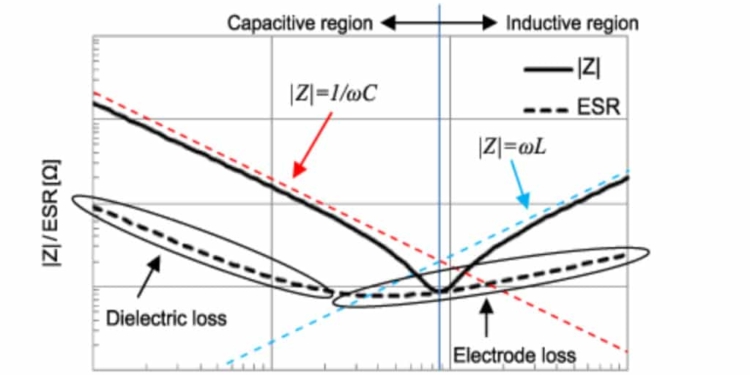Source: EDN article
Bill Schweber explains some basic understanding of capacitor’s ESR and why it is of interest.
Back in school when being introduced to the basics of electrical engineering, we learned that the ideal capacitor was a simple, basic reactive element. It was easily modeled with capacitive reactance
XC = 1/(2πfC)
where f is the frequency and C is the capacitance value. Then, in some (but not all) courses, that idealistic façade was stripped away and we learned that reality is not so simple. There’s an important real-world aspect to the ideal capacitor, called its equivalent series resistance (ESR), which quantifies the capacitor’s effective resistance RS to RF currents.
This ESR actually has multiple constituent elements, including the part contributed by the electrodes and terminal leads, as well as that due to the dielectric, plate material, electrolytic solution, all as measured at a particular frequency. If you look at ESR in terms of the actual series resistance, the leakage resistance, and the dielectric loss, ESR goes from being just a resistor in series with an ideal capacitor to something more complicated, Figure 1. (Note that real capacitors also have a complementary parasitic self-inductance called equivalent series inductance or ESL, but that’s another story for another time.)

Figure 1 The theoretical capacitor is a simple reactive element, but a real one has equivalent series resistance due to ohmic series resistance, leakage resistance, and dielectric loss. (Image courtesy of QuadTech, Incorporated)
Why should we worry about ESR? For basic DC-only blocking circuits, ESR may have little impact. However, when you are designing a switching power supply or an RF circuit, ESR obviously affects your modeling, and real-world performance of the circuit. ESR shifts and degrades the resonance of the circuit in which the capacitor is functioning, as well as the Q (quality factor) of the circuit. ESR is a function of frequency, obviously, as well as capacitor type, materials, construction, capacitor value, and many other factors, Figure 2.

Figure 2 ESR is a function of many factors including operating frequency and capacitor material and type (Image courtesy of Murata)
The implications of ESR go beyond performance. As a “resistor” it also creates thermal power dissipation P as a function of the current through the capacitor, with P = I2RS. Not only don’t we like to waste power in most cases in terms of energy use (cost) and run time, but this dissipation adds to the thermal load of the system. Even if it doesn’t burden the system, it can soon exceed the thermal rating of the capacitor itself. If you go through the numbers using, for example, a basic 0.47 μF capacitor with modest ESR of about 0.1 Ω at 1 GHz will dissipate will around 75 mW – which is not much or is a lot, depending on the circuit and system details, and capacitor rating.
The obvious question is how do you determine ESR? For most engineers, the answer is clear: you look at the vendor data sheet numbers and the graph of ESR versus frequency. Reputable vendors provide detailed ESR specifications which define not only the value but also how they determine it.
If you want to measure ESR yourself, it’s not an easy task. An article in Microwave Journal, “The Methods and Problems of Capacitor ESR Measurement,” (free, but registration required) went into considerable detail on a long-standing and accepted way of doing so along with its limitations, as well as a more-advanced technique; the various vendors may use other approaches. Regardless of which one you try, there are many test and instrumentation subtleties, as there always are when dealing with signals and components at GHz and higher frequencies.
Has one of your design ever been compromised by excessive ESR that you did not expect? Have you ever tried to dig into the details of the ESR of a specific capacitor you were using, or tried to measure ESR yourself?
Bill Schweber is an EE who has written three textbooks, hundreds of technical articles, opinion columns, and product features.
References
- Murata, “What are impedance/ESR frequency characteristics in capacitors?“
- QuadTech, “Equivalent Series Resistance (ESR) of Capacitors“
featured image credit: Murata


































